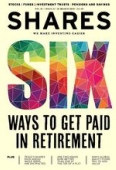Archived article
Please note that tax, investment, pension and ISA rules can change and the information and any views contained in this article may now be inaccurate.
Are two heads ever better than one at the top of a PLC?

Less than two years since Standard Life and Aberdeen Asset Management merged, the enlarged group is finally dispensing with its unpopular co-CEO structure as Martin Gilbert is relegated to a different role.
The boss of Aberdeen Asset Management before the tie-up, Gilbert will remain with Standard Life Aberdeen (SLA) as vice chairman for the time being with a focus on client relations, although some speculate his days are numbered with the firm.
The news raises the question of why companies use a co-CEO structure in the first place. In this article we discuss whether there are ever any benefits of having two people at the top and the main criticisms of such an approach.
We also look at the other end of the spectrum where some companies dispense with having a separate CEO altogether and just combine the roles of chairman and chief executive.
DOUBLE THE COST
Having more than one chief executive is unusual and an obvious argument against having two CEOs is the cost. The combined pay packet of Gilbert and his erstwhile counterpart Keith Skeoch, including bonuses, came in a little under £2m in 2018. And this was after a tough year for the company which saw outflows of £41bn and flat profit.
In 2017 their combined pay totalled more than £4.3m. It’s no wonder some people joked that the company was getting two chief executives for the price of three.
For smaller companies this could be even more of a burden. For example, cosmetics seller Warpaint London (WPL:AIM) also has a joint chief executive structure. The combined remuneration of Samuel Bazini and Eoin Macleod in 2017 was significantly more modest than that of Skeoch and Gilbert at £400,000 but this was still a material outlay in the context of a pre-tax profit for that
year of £6.9m.
POTENTIAL FOR CLASHES
A second possible problem is a lack of focus and the potential for clashes at the top over strategy.
In the US media and merchandising company Martha Stewart Living Omnimedia introduced a co-CEO structure in 2008 under Wenda Millard and Robin Marino. But within 12 months and after reporting a $15.7m loss, Millard left with chairman Charles Koppelman acknowledging there had been tension between the two individuals.
The co-CEO leadership of Germany’s Deutsche Bank was widely perceived as a failure before the announced exit of Anshu Jain and Jurgen Fitschen in 2015. The struggles of their successor John Cryan, who was himself pushed out in 2018, suggests the company’s problems may have run deeper than just its management structure.
The most long-standing co-CEO set-ups tend to be situations where the founders are heading up the company. For example, cousins and co-founders George Roberts and Henry Kravis have run private equity giant KKR together for years.
FOUNDERS IN FOCUS
Web-based women’s fashion brand Sosandar (SOS:AIM) is run by co-founders and now joint chief executives Alison Hall and Julie Lavington and the company has enjoyed a decent start to life
as a public company since listing in March 2018.
Online fast fashion play Boohoo (BOO:AIM) has also been a success story under joint CEOs who were also founders of the business. However, the company appears to have accepted that the next stage in its development requires a change of approach, with Mahmud Kamani and Carol Kane recently agreeing to move into the role of executive chairman and executive director respectively and former Primark man John Lyttle taking sole charge.
CAN IT EVER WORK?
US software business Salesforce courted controversy by moving in the opposite direction and adding an extra CEO, with Keith Block stepping up from a chief operating officer role to join the company’s founder Marc Benioff.
One of the key arguments for having two people at the top is that they might have different and complementary skill-sets. And the manager of global equity fund Blue Whale Growth (BD6PG56) Stephen Yiu, who hold Salesforce, observes that Benioff is best at ‘culture, brand and vision’ while Block excels at ‘sales, operations and execution’.
Yiu adds: ‘Ultimately, Block is a world-class executive. If his promotion to co-CEO keeps him at Salesforce as opposed to a competitor, then it’s an excellent move on Benioff’s part’.
CHAIRMAN AND CEO
So what about situations where rather than having two people operating as CEOs, there is just one person who combines the roles of both chairman and chief executive?
Legal & General Investment Management says separating the position of chair and CEO is generally advisable. It comments: ‘The roles of chair and CEO are substantially different and therefore require distinct and complementary skills and experience.
‘While the CEO focuses on running the company’s business, day-to-day operations, leading and executing the company’s long-term strategy. The chair, along with the rest of the board, is responsible for overseeing the actions of management. They are expected to act as a counter-power and constructively challenge the executive directors.
‘In addition, the chair leads the evaluation of the board, including company management. They are also responsible for the running of the board, setting the agenda, board composition and succession planning matters, such as the recruitment of a new CEO.’
The chairman/CEO joint role has been more prevalent in the resources sector. For example, Randeep Grewal is chairman and CEO of Chinese coal bed methane play G3 Exploration (G3E) and Peter Levine has combined both roles at President Energy (PPC:AIM) since 2015 in a move explained at the time as a ‘streamlining’ exercise or, in other words, to save money.
Important information:
These articles are provided by Shares magazine which is published by AJ Bell Media, a part of AJ Bell. Shares is not written by AJ Bell.
Shares is provided for your general information and use and is not a personal recommendation to invest. It is not intended to be relied upon by you in making or not making any investment decisions. The investments referred to in these articles will not be suitable for all investors. If in doubt please seek appropriate independent financial advice.
Investors acting on the information in these articles do so at their own risk and AJ Bell Media and its staff do not accept liability for losses suffered by investors as a result of their investment decisions.

 magazine
magazine










